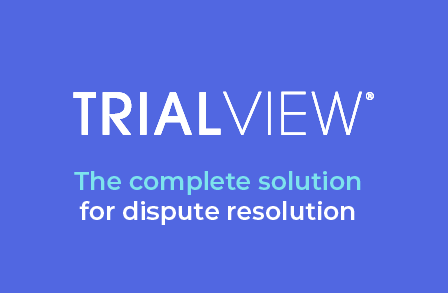
By Eimear McCann, Commercial Director, TrialView.
Are we living in binary times? In an age of cognitive overload, the temptation to veer to extremes has never been so heightened, and yet conversely, buzzwords like hybrid and blended have infiltrated our vernacular, offering just enough ambiguity to assuage digital anxiety.
The great catalysis, marked by the first lockdown in March 2020, inexorably propelled the world of disputes into some initial disarray, but recovery was remarkably swift. On a rudimentary level, the rapidity of transition was possible simply because the technological infrastructure existed to support the necessity. Lawyers were able to emulate in-person hearings using platforms historically used in a social, non-professional context. Witnesses and experts were able to join from iPads and mobile phones from any location. The disputable democracy of technology had finally enveloped the world of law.
Etymology tells us that the original significance of words like ‘remote’ and ‘virtual’ (both with Latin and French derivations) still resonate, with the latter being defined as ‘very close to being something without actually being it’. Within that terse definition lies a plethora of challenges. How can you ensure that virtual hearings are very close to being in-person hearings, without all parties being there in-person?
Almost two years on, how much progress has been made, and how loyal have we been to the true meaning of ‘virtual’? Starting out with the positives, many lawyers have not only adapted, but have embraced remote hearings. Many report increased freedom, flexibility, and team collaboration; electronic bundling and online document management offers access to team members who may have been precluded by virtue of geography or logistics. Data rooms allow agility, enabling lawyers to search, organise, annotate, and hyperlink case material collaboratively, from any device, thanks to an escalation in the use of the cloud and a renewed focus on tech-enabled working on a business-wide level. Commercially, for all involved, remote hearings make sense.
Holistically though, the advantages of going digital go way beyond our innate desire for increased flexibility or economic efficiency. Taking historic international arbitration as an example, how sustainable are/were in-person hearings? With the disparate strands of lawyers and witnesses, forests of paper and carbon dioxide emissions, presided over by a panel of arbitrators, it is more a question of necessity than preference. The push for Greener Disputes has gained true momentum and a reversion to physical hearings seems unimaginable.
Naturally, disruption cannot happen without challenges. Aiming for ‘very close to being something without actually being it’ leaves emulation often falling short of reality. Remote, by its very definition, naturally means that people may feel removed from proceedings and less incentivised to engage in a transparent way.
Computing all of the data, activity and the sense of gravitas of a hearing room from one screen, whether a laptop or a mobile, can put a lot of pressure on cognitive processing, presenting challenges for witnesses, advocates and decision makers. Presenting evidence on separate devices; court and tribunal backlogs; losing the social messaging of body language or non-verbal cues; technical glitches (and the detraction from witness credibility) and generic, inherent frustrations have all played a part.
Some of these challenges can be remedied, but we do need to deviate from assumptions. There can be no doubt that staff absences and self-isolation have played their part in delays and backlogs; however, on an anecdotal level, many hearings are simply taking longer. There is an argument that the protraction does not stem from longer submissions or more detailed witness evidence, but from the engagement of tech which isn’t designed for the judicial setting.
Reverting to the definition of ‘virtual’, the aim is to replicate the in-person experience, or at least to get as close as possible. This means that evidence presentation should be as easy (arguably easier in some cases) digitally as it would be in a physical hearing, with the capability to guide all parties through the evidence on screen, with easy navigation and interaction as the presenter, and with the option for witnesses to follow evidence presentation on their own device. The gravitas of the hearing shouldn’t be lost if the platform has been designed only for this purpose, and the social data of body language and human interaction should be almost as sharp as in real life, again if the video integration was specifically designed with these nuances in mind.
Overall, a binary future of either/or looks improbable. Hybrid, and its varying connotations, appears to be the preference of practitioners, judges, and clients, achieving the goal of reducing overall costs, complying with a vision for greener disputes and offering parties the possibility of returning to the rigour of in-person hearings, where desirable or necessary.
‘Hybrid’ is suitably equivocal to encompass a host of scenarios, with some parties in the same room as the judge or panel, while others join remotely, or it could be the amalgam of remote interim hearings, with the final hearing in person. In a sense, the definition matters less than the technology enabling it. If there is a global recognition that hybrid has permanence, there is a need for an introduction of certain standards and processes to facilitate that future, rather than a disjointed, reactive response.
Distilling this through a tech lens, pragmatism would encourage the engagement of one platform to streamline the digital disputes process, from E-bundling through to the virtual hearing. Not only does this option offer certainty and efficiency, but it saves on time and cost, whilst offering enough autonomy to replicate in-person proceedings.
The future of dispute resolution is, without doubt, going to be tech-driven, with an increasing focus on data analytics and with scope for augmented or virtual reality and a more immersive experience. Above all though, if we can combine the naturality of real life with the benefits of a digital interface, we are embracing a world than is more blended than binary, and in doing so, rejecting the stark limitations of binary thinking.
–
TrialView is designed to streamline the disputes process, from E-bundling through to the virtual or hybrid hearing, all within one secure and cohesive cloud-based platform. TrialView’s expansion into the UK marks the beginning of ambitious plans for growth.
You can find out more about TrialView’s virtual hearing solutions here.

[ Artificial Lawyer is proud to bring you this sponsored thought leadership article by TrialView. ]